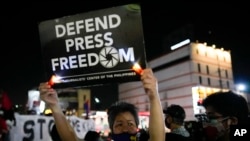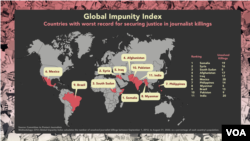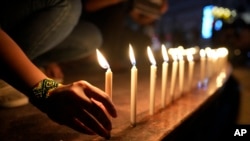Radio is a powerful medium in the Philippines, with local journalists able to easily buy up airtime to reach wide audiences. But with that reach comes risk.
In October, gunmen killed Percival Mabasa, a popular community radio host known as “Percy Lapid.” He was the third radio journalist to be killed in the country so far in 2022.
And while police quickly arrested a suspect over Mabasa’s shooting, analysts say the Philippines generally has a poor record in securing justice in media killings.
The Philippines ranks seventh on the Global Impunity Index, which calculates the number of unresolved journalist murders as a percentage of a country’s population. Since the index — released Tuesday by the Committee to Protect Journalists — was started in 2008, the Philippines has appeared every year.
That impunity to the killers of journalists fosters a more dangerous environment. The Philippine nonprofit foundation, the Center for Media Freedom and Responsibility, has documented 281threats or attacks in the past six years.
Of those 281 incidents, claimed Jonathan de Santos, chair of the National Union of Journalists of the Philippines (NUJP), “37 were attributed to local governments and 37 to the police, which local governments have a degree of control over.”
He added that nearly all the journalists killed since 2016 worked in radio.
VOA sent emails to the Presidential Management Staff and national police requesting comments. Neither had responded by the time of publication.
Local airtime
Many radio stations in the Philippines are funded by political interests, and journalists buy segments of airtime, known as “blocktiming,” a unique practice in the Philippines, to broadcast their own shows.
Allowing journalists to buy up airtime allows for greater coverage of local or underreported news.
“Radio is still the medium with the biggest reach because of the low cost of access and because it is available even in geographically remote areas,” said Santos, who is also news editor at Philstar.com. “Radio journalists in the Philippines also usually talk about local, even hyperlocal, issues.”
But the combination of political affiliations and block-time shows being less regulated means these journalists can become an easy target, Santos told VOA via email.
“Since [the journalists] are technically not employed by the station, there is little control or oversight over blocktime content,” Santos said. “The shows could also be funded by politicians and used for partisan ends. Many [blocktime hosts] also often use plain, even aggressive language, which makes them more relatable to their audiences but also means criticism of local government officials and policies might cut deeper.”
In Mabasa’s case, the “Lapid Fire” host appeared popular among listeners. The YouTube channel where he uploaded his broadcasts had 224,000 subscribers. On it, he criticized former President Rodrigo Duterte and current President Ferdinand Marcos Jr., and accused officials of corruption and abuse of power.
The Philippines journalists union is advocating to reduce block-timing and offers training.
But in a country with a poor record for media safety, even the most experienced journalists find themselves under fire from critics.
Lourdes Escaros is a news anchor at RMN DZXL, one of the country’s largest and oldest radio networks. She told VOA that negative news about the government often triggers abuse and death threats directed at her and her family.
“Threats online [are] very rampant. Like, they want to kill me and my son. [Or] stop criticizing the government or else they will kill me.
“Sometimes, they tagged me on Facebook just to attack me and criticize me for attacking the government. Duterte's time was hell. Trolls and the government were, like, partners in crimes in attacking us,” Escaros said.
Still, Escaros has no plans to quit.
“It’s my dream. I love it,” she told VOA. The job may not pay well, but “I chose this profession, and this is my life.”
Under Duterte’s administration, the government formed a Presidential Task Force on Media Security in 2017 to investigate attacks. But local journalists say it has had limited success.
The task force’s Facebook page is updated regularly. As recently as September, it posted a statement about an attack. But Raymund Villanueva, a journalist for Kodao Productions and a safety officer at the NUJP, believes the body is inactive.
“There has been no administrative order by Marcos Jr. ordering its continuation. So, I don’t think it’s a legal entity at this point,” Villanueva said. “There has been no appointment of a new executive director, so we’re not sure if it still exists legally. And we’ve dismissed it.”
The Presidential Task Force on Media Security did not respond to VOA’s email requesting comment.
Villanueva said harassment affects digital as well as radio journalists.
Based in Quezon City outside the capital, Manila, Kodao Productions focuses on underreported issues. Because of that, it has been criticized as anti-government.
Kodao regularly reports on the National Democratic Front of the Philippines, a leftist political group whose armed supporters have carried out attacks for decades.
Villanueva said Kodao reports on its “peace talks with the government, its agendas on human rights and international humanitarian law, national industrialization and rural development.”
“It’s just our stories are strong on human rights, environment, Indigenous peoples. It’s necessarily critical of social problems in the Philippines,” said Villanueva. “We’re not the type to directly attack the government.”
The outlet has weathered harassment, including cyberattacks in late 2017 and early 2018 that crashed the Kodao website, Villanueva said.
Kodao separately used to run programs to train people in poorer communities to become radio broadcasters.
But because of risks to journalists, the media outlet suspended in-person training.
“We’ve pretty much stopped putting up registrations because those that we train are now in jail or are dead or are being hounded by the military,” Villanueva said.
Conditions for media have “never been good going in the Philippines,” said Villanueva. And under the Marcos Jr. administration, "essentially there is no difference, change or respite."
The Office of the Press Secretary, the head of Presidential Communications Group in the Philippines, recently made a statement on Facebook that it is committed to protect journalists.
The country in 2022 ranked 147 out of 180 on the Press Freedom Index, where 1 has the best conditions for media.















